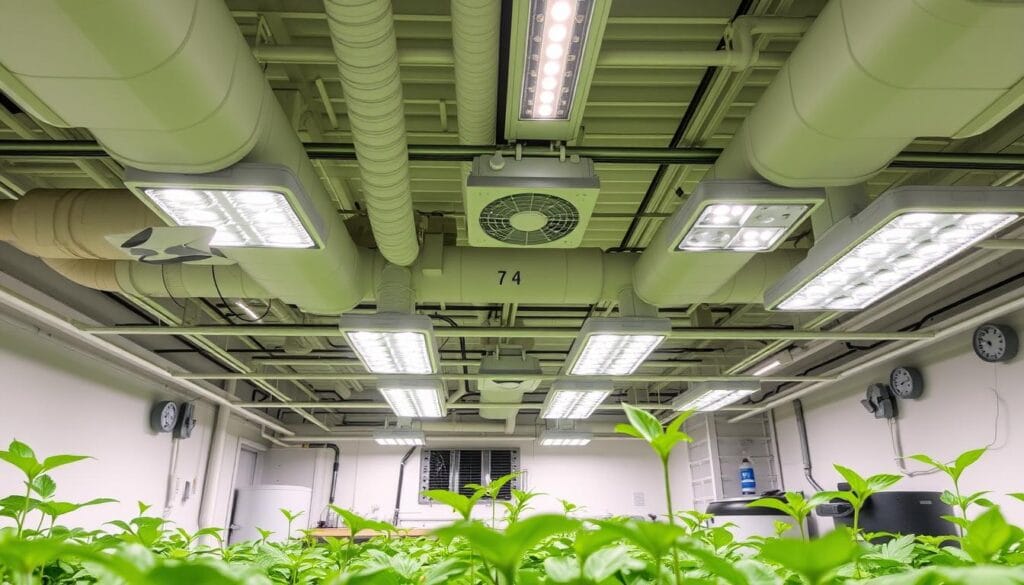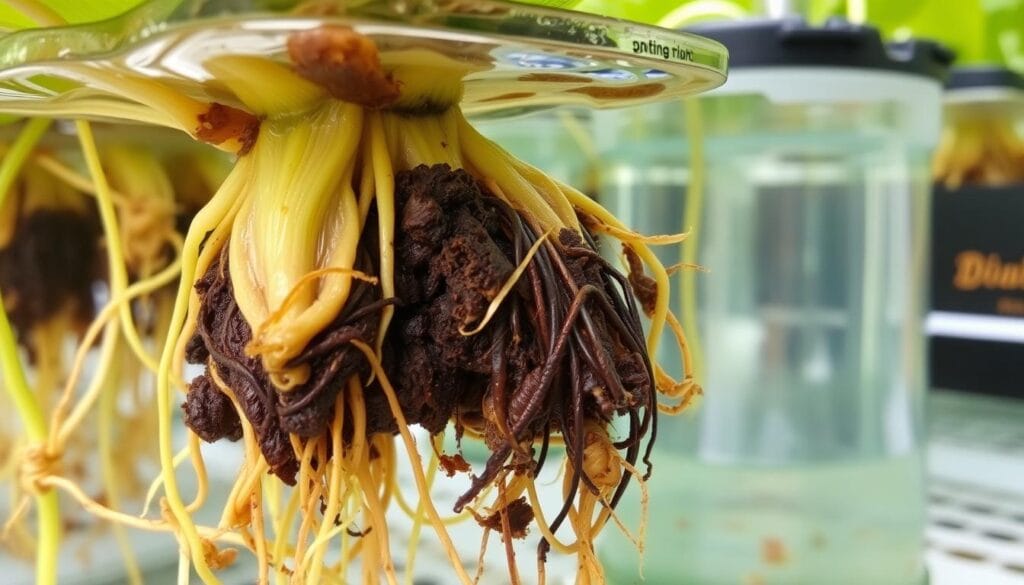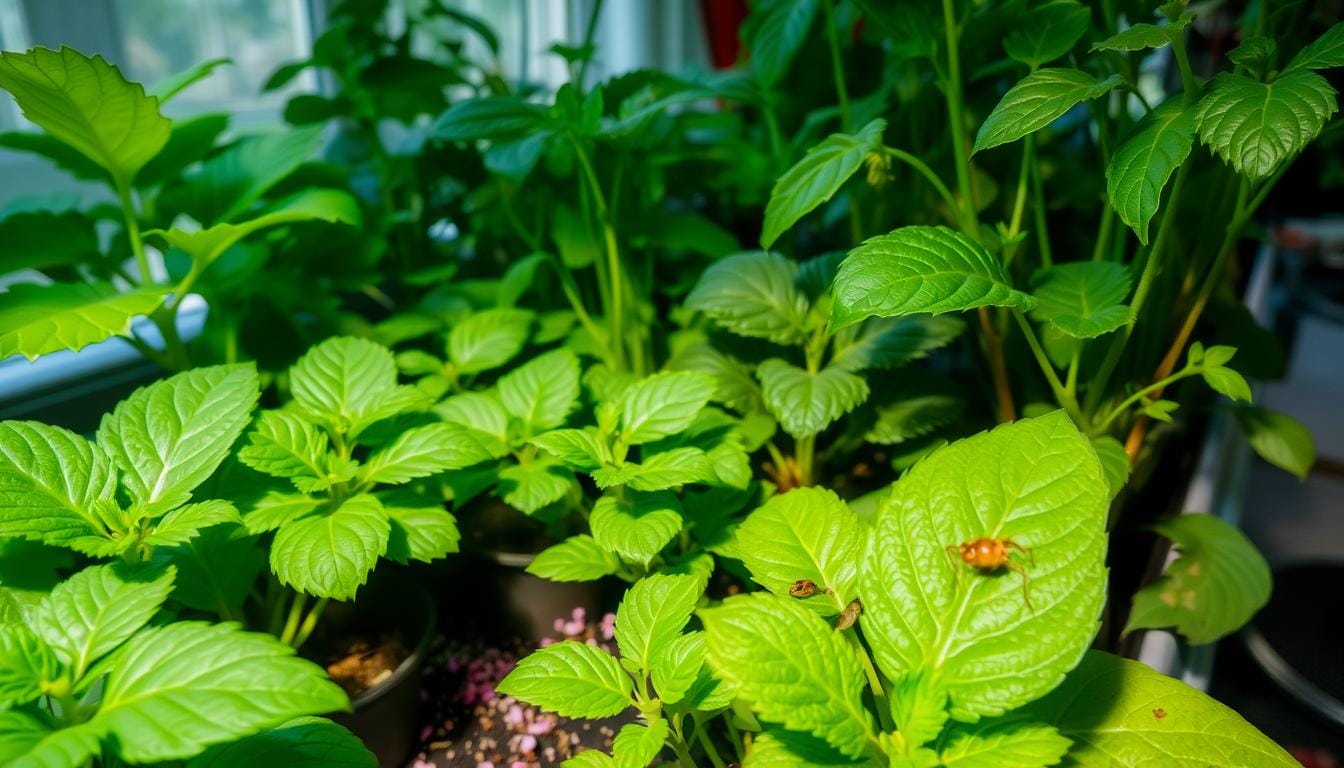Hydroponic growth mistakes are common, even among experienced growers. Hydroponic growing is popular for its high yields and quick growth, but errors can harm plants. Here, we’ll look at five frequent mistakes and how to fix them.
Managing the nutrient solution is a big challenge. Mixing nutrients wrong, feeding too much, or ignoring EC and pH can harm plants. Keeping the nutrient balance right and watching your solution is key for healthy plants.
Another big problem is pH imbalances. Most plants need a pH between 5.5 and 6.5 in hydroponics. If it’s off, plants can’t absorb nutrients well. Testing and adjusting pH regularly is vital for plant health.
Key Takeaways
- Proper nutrient solution management, including monitoring EC and pH levels, is crucial for successful hydroponic growing.
- Maintaining the optimal pH range of 5.5 to 6.5 is essential for optimal nutrient uptake and plant health.
- Inadequate lighting, poor air circulation, and system maintenance oversights can all negatively impact plant growth and yields.
- Early detection and correction of any issues are key to preventing further damage and ensuring a bountiful harvest.
- Understanding the unique requirements of hydroponic systems and dedicating time to research and planning can help you avoid common mistakes.
Understanding Basic Principles of Hydroponic Growing
Hydroponic cultivation allows plants to grow without the use of soil. It uses a nutrient-rich solution instead. To grow plants well, you need to know about different systems and what’s needed for plant health.
Types of Hydroponic Systems
For beginners, systems like the wick, water culture, or ebb and flow are good to start with. More complex systems include the nutrient film technique and aeroponic systems. Each has its own benefits and needs, so pick the right one for your plants.
Essential Components for Success
Keeping the nutrient solution balanced is key for hydroponic plants. They get all their nutrients from this liquid. It’s also important to keep the pH levels right, between 5.5 and 6.5, especially for plants like cannabis. You’ll also need good grow lights and air circulation to keep your plants healthy.
Importance of Research and Planning
Before starting, research the best plants for hydroponics, like leafy greens, tomatoes, or strawberries. They do well in hydroponic systems. Avoid root vegetables, as they need soil.
| Hydroponic System | Pros | Cons |
|---|---|---|
| Wick System | Simple, low maintenance | Not suitable for high water demand plants |
| Water Culture | Ideal for leafy greens, requires aeration | Limited to plants that thrive in constantly wet conditions |
| Ebb and Flow | Versatile, can accommodate a range of plants | Requires more complex setup and monitoring |
| Nutrient Film Technique | Continuous nutrient solution flow, efficient | Potential for root rot if not properly maintained |
| Aeroponic | High oxygen levels, reduced water usage | Prone to clogging, requires precise misting |
Learning the basics of hydroponic growing opens up a world of plant cultivation. It’s a rewarding journey beyond traditional gardening.
Nutrient Solution Management and Common Errors
Managing nutrients is key in hydroponic systems. Too much or too little food for your plants can cause problems. It’s important to find the right balance to help your garden grow well.
Essential macronutrients, such as nitrogen, phosphorus, and potassium, play a crucial role in supporting healthy plant growth. Micronutrients like calcium, magnesium, and iron also play important roles. The best pH for hydroponics is between 5.5 and 6.5, helping plants absorb nutrients well.
Too much food can harm your plants, causing them to grow slowly. Not enough food leads to weak and unhealthy plants. Always use nutrients made for hydroponics to avoid damaging your system.
Use PPM, EC, or TDS meters to check if your plants are getting the right amount of nutrients. Regularly clean and refill the system to keep nutrients balanced.
| Nutrient Concentration | Recommended Range | Impact on Plants |
|---|---|---|
| Overfeeding | Above 1.2 EC | Nutrient burn, stunted growth |
| Underfeeding | Below 0.6 EC | Nutrient deficiencies, weak plants |
| Optimal Range | 0.6 – 1.2 EC | Healthy, vigorous plant growth |
By keeping a close eye on your hydroponic nutrient solution, you can prevent common problems. This ensures your plants grow strong and healthy.
pH Level Monitoring and Adjustment Challenges
Keeping the right pH level is key for good nutrient absorption in hydroponics. Most plants, like cannabis, do best in a pH of 5.5 to 6.5. If the pH is off, plants can’t absorb nutrients well, slowing their growth.
Optimal pH Ranges for Different Plants
Cannabis likes a pH of 5.5 to 6.5, but other plants might prefer different levels. It’s vital to check and adjust the pH often. This ensures each plant gets the nutrients it needs to grow well.
Tools for pH Testing
A pH testing kit or meter is a must for keeping an eye on your system’s pH. Do pH tests regularly, especially when starting out. This helps catch and fix any pH problems fast.
Correcting pH Imbalances
If your system’s pH is not in the right range, act quickly. Use pH up or down solutions to fix it, adding a little at a time. Keeping the nutrient levels balanced is crucial for healthy plants and good yields.
“Proper pH management forms the foundation of a thriving hydroponic garden, ensuring optimal nutrient absorption for healthy plant growth. Neglecting to monitor and adjust pH levels can lead to nutrient deficiencies, stunted growth, and even plant death.”
Water Quality and Hard Water Issues
Keeping the right water quality is key for your hydroponic garden’s success. Hard water is a common challenge that affects plant growth and nutrient absorption.
Hard water, with over 200 parts per million (PPM) of total dissolved solids, causes problems. High levels of minerals like calcium and magnesium make it hard to add needed nutrients. This can lead to nutrient deficiencies and imbalances, hurting your plants.
Also, hard water’s calcium compounds can cause calcium deposits. This can lead to a calcium deficiency in your plants. To fix this, you might need to dilute the water with distilled or reverse osmosis-treated water. Or, using a reverse osmosis or activated carbon filter can remove excess minerals and improve water quality.
| Indicator | Optimal Range | Implications of Hard Water |
|---|---|---|
| Total Dissolved Solids (TDS) | 100-300 PPM | Levels above 300 PPM can limit nutrient addition and lead to nutrient absorption issues. |
| Calcium Hardness | 40-100 PPM | High calcium levels can cause calcium deposits and deficiencies in plants. |
| Magnesium Hardness | 10-30 PPM | Excess magnesium can interfere with the availability of other essential nutrients. |
By monitoring your water quality and fixing hard water issues, you can create a great growing environment. This ensures your hydroponic plants get the nutrients they need and thrive.
“The key to success in hydroponic gardening is to maintain a delicate balance between nutrient levels, pH, and water quality. Addressing hard water issues is a crucial step in this process.”
Hydroponic Growth Mistakes in Lighting Setup
Lighting is key to a successful hydroponic garden. Yet, many gardeners make mistakes in their lighting setup. This can harm plant growth. Let’s look at common lighting issues and how to fix them.
Choosing the Right Light Type
Not all grow lights are the same. LEDs and T5 fluorescent lights are best for hydroponics. LEDs save energy and last long, offering the right light for plants. T5 lights are great for herbs and leafy greens.
Stay away from cheap LEDs. They can give plants bad light, hurting their growth and yield.
Light Positioning and Intensity
Where and how bright your lights are matters a lot. LEDs should be 12-18 inches above plants. Fluorescents can be closer. Make sure the light is strong enough, about 65 watts per square foot.
Too little or too much light can harm plants. It can cause them to stretch, get light burn, or grow slowly.
Light Schedule Management
Plants need different light times at different growth stages. Vegetative plants need 14-16 hours of light. Flowering plants do best with 12 hours of light and 12 hours of dark.
Managing light schedules right is key to growing healthy plants. This leads to better crops.
| Lighting Type | Recommended Use | Key Benefits |
|---|---|---|
| LED Grow Lights | Suitable for all growth stages | Energy-efficient, customizable light spectra, long-lasting |
| T5 Fluorescent Lights | Ideal for growing herbs and leafy greens | Efficient, suitable for beginners |
| HID (Metal Halide and High-Pressure Sodium) | Recommended for larger setups | Powerful, suitable for different growth stages |
Getting your hydroponic lighting right is vital for healthy plants. By avoiding common mistakes and following best practices, you can make your garden thrive.
Environmental Control and Ventilation Problems
Keeping the right environment is key for your hydroponic plants to do well. Without enough air, humidity can get too high. This can lead to mold and diseases. It’s important to watch the temperature, humidity, and air flow in your space.
The best temperature for indoor plants is between 22°C and 28°C (72°F to 82°F). Humidity should be between 40% and 60%. Good air flow, thanks to fans, helps keep plants healthy.
- Make sure your fans, filters, and ducts work well for good air flow.
- Check temperature and humidity often with thermometers and hygrometers.
- Move fans around to get air to all parts of the area, avoiding damp spots.
Ignoring these needs can cause problems like weak growth and more pests. By controlling temperature, humidity, and air, you help your plants grow well.
| Crop | Ideal Temperature Range | Ideal Humidity Range | Optimal Light Intensity |
|---|---|---|---|
| Lettuce | 18°C to 24°C (64°F to 75°F) | 40% to 60% | 200 to 400 μmol/m²/s |
| Tomatoes | 21°C to 27°C (70°F to 80°F) | 50% to 70% | 600 to 1000 μmol/m²/s |
| Leafy Greens | 18°C to 24°C (64°F to 75°F) | 40% to 60% | 200 to 400 μmol/m²/s |
By keeping the right temperature, humidity, and air flow, you make a perfect place for your plants to grow.

“A well-designed ventilation system is the backbone of a successful hydroponic grow operation. It’s essential for regulating temperature, humidity, and air flow to support plant health and maximize yields.”
System Maintenance and Cleaning Oversights
Keeping your hydroponic system clean is key to its long life and best performance. If you ignore these tasks, you might face leaks, contamination, and other problems. These can harm your plants’ health.
Regular Cleaning Schedule
Clean your hydroponic system every 2-3 weeks. This means draining the reservoir, flushing the growing media and roots, and cleaning the reservoir, pumps, and tubing. Regular cleaning stops organic matter buildup. This can help prevent algae and harmful organisms.
Equipment Maintenance Tips
- Look for leaks at joins and valves. Make sure the reservoir can hold the needed nutrient solution volume.
- Wash the system parts, like pumps and spray nozzles, to avoid blockages. This keeps water and nutrient flow smooth.
- Check hoses, tubing, and other equipment for wear or damage. Replace them if needed.
Preventing System Contamination
Keep the area around your hydroponic system clean to avoid disease and pests. Regularly check for signs of contamination, like algae or microbial buildup. Act fast to fix any problems.
By sticking to a cleaning and maintenance routine, your hydroponic system will work well. This prevents leaks, contamination, and other problems that can harm your plants’ health and growth.
| Statistic | Value |
|---|---|
| Hydroponic farming conserves up to 90% of water compared to traditional soil-based farming methods. | 90% |
| Hydroponics uses approximately one-tenth of the water consumption of conventional agricultural methods. | 10% |
| Hydroponically grown plants can achieve plant densities up to 16 times greater than soil-grown plants. | 16 times |
“It’s recommended to regularly monitor water quality parameters in hydroponic systems, including pH, nutrient concentration, and dissolved oxygen levels.”
Root Health and Disease Prevention
In hydroponics, keeping roots healthy is key to plant success. Root rot, caused by fungi or bacteria, can harm your system. Also, pests can threaten your plants, so watch them closely and act fast.
Use a good watering schedule to let growth media dry a bit between waterings. This helps roots get enough oxygen. Check your roots often for disease or pests like discoloration or insects.
- Spotting and treating root problems early can save your hydroponic system.
- Right nutrient levels and pH in your solution help roots grow strong against root rot and pest infestations.
Acting quickly on root health issues can prevent big problems. Preventing disease is easier than fixing it after it starts.

“The key to maintaining healthy roots in hydroponics is a combination of vigilance, proper watering practices, and a keen eye for early signs of trouble.”
Plant Spacing and Growth Management
Proper plant spacing is key for your hydroponic setup to grow well. Overcrowding can cause problems like poor nutrient delivery and light blockage. Make sure to give your plants enough room for healthy growth.
Regular pruning helps your plants grow strong and prevents them from getting tangled. Think about the size and growth rate of your plants when planning your layout. This ensures each plant gets what it needs to thrive. Good pruning keeps your hydroponic system balanced and healthy.
Managing plant spacing and growth well boosts your hydroponic operation’s productivity. Finding the right balance between plant density and individual needs is crucial. This approach leads to abundant harvests and a thriving hydroponic environment.

